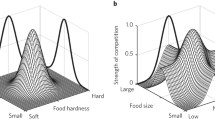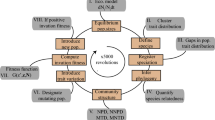Abstract
The notion of ‘community-wide character displacement’ hypothesizes that locally co-existing sets of competing species should be less similar than expected when compared to random expectations from a broader regional species pool. Here I use a mechanistic approach to the niche concept to show how this expectation is dependent on the types of traits involved. I investigate how two different niche components, those that relate to species' requirements (or responses to environmental factors) versus those that relate to species' impacts (or effects on environmental factors), affect predictions about the similarity of locally co-existing species. In contrast with more conventional approaches that focus on species impacts, I focus on species responses to conclude that locally co-existing species should be more similar in such traits than expected on the basis of random assortment from a larger equilibrium regional biota. In addition, I explore the evolutionary implications of exceptions that might favour the co-existence of species with dissimilar traits (especially those that determine species' impacts on the environment) and conclude that these implications differ when species compete for shared resources, interact via shared predators, or interact via both mechanisms. The analysis developed in this paper shows that the co-existence of species that are more similar than expected by chance is not incompatible with the notion of strongly interacting species in saturated local communities near equilibrium.
Similar content being viewed by others
References
Abrams, P.A. (1975) Limiting similarity and the form of the competition coefficient. Theor. Pop. Biol. 8, 356–375.
Abrams, P.A. (1986) Character displacement and niche shifts analyzed using consumer-resource models of competition. Theor. Pop. Biol. 29, 107–160.
Abrams, P.A. (1988) Resource productivity and consumer-species diversity: Simple models of competition in spatially heterogeneous environments. Ecology 69, 1418–1433.
Abrams, P.A. (1990a) Ecological vs evolutionary consequences of competition. Oikos 57, 147–151.
Abrams, P.A. (1990b) Mixed responses to resource densities and their implications for character displacement. Evol. Ecol. 4, 93–102.
Agren, G.I. and Fagerstrom, T. (1984) Limiting dissimilarity in plants: Randomness prevents exclusion of species with similar competitive abilities. Oikos 43, 369–375.
Bowers, M.A. and Brown, J.H. (1982) Body size and co-existence in desert rodents: Chance or community structure? Ecology 63, 391–400.
Brown, J.H. (1975) Geographical ecology of desert rodents. In Ecology and Evolution of Communities (M.L. Cody and J.M. Diamond, eds), pp. 315–341. Belknap Press, Cambridge, MA.
Brown, J.S. (1989) Desert rodent community structure: A test of four mechanisms of co-existence. Ecol. Monogr. 59, 1–20.
Brown, J.S. and Vincent, T.L. (1987) Coevolution as an evolutionary game. Evolution 41, 66–79.
Brown, J.S. and Vincent, T.L. (1992) Organization of predator-prey communities as an evolutionary game. Evolution 46, 1269–1283.
Chesson, P. (1990) MacArthur's consumer-resource model. Theor. Pop. Biol. 37, 26–38.
Cody, M.L. (1991) Niche theory and plant growth form. Vegetatio 97, 39–55.
Colwell R.K. and Winkler, D.W. (1984) A null model for null models in biogeography. In Ecological Communities: Conceptual Issues and the Evidence (D.R. Strong, D.S. Simberlo., L.G. Abele and A.B. Thistle, eds), pp. 344–359. Princeton University Press, Princeton, NJ.
Diamond, J.M. (1975) Assembly of species communities. In Ecology and Evolution of Communities (M.L. Cody and J.M. Diamond, eds), pp. 342–444. Belknap Press, Cambridge, MA.
Feldman, M.W. and Roughgarden, J. (1975) A population's stationary distribution and chance of extinction in a stochastic environment with remarks on the theory of species packing. Theor. Pop. Biol. 7, 197–207.
Giller, P.J. (1984) Community Structure and the Niche. Chapman and Hall, London.
Grover, J.P. (1994) Assembly rules for communities of nutrient limited plants and specialist herbivores. Am. Nat. 143, 258–282.
Harvey, P.H., Colwell, R.K., Silvertown, J.W. and May, R.M. (1983) Null models in ecology. Ann. Rev. Ecol. Syst. 14, 189–211.
Holt, R.D. (1977) Predation, apparent competition and the structure of prey communities. Theor. Pop. Biol. 12, 197–229.
Holt, R.D., Grover, J.P. and Tilman, D. (1994) Simple rules for interspecific dominance in systems with exploitative and apparent competition. Am. Nat. 144, 741–771.
Hutchinson, G.E. (1959) Homage to Santa Rosalia, or why there are so many kinds of animals? Am. Nat. 93, 145–159.
Jackson, D.A., Somers, K.M. and Harvey, H.H. (1992) Null models and fish communities: Evidence of nonrandom patterns. Am. Nat. 139, 930–951
Jeffries, M.J. and Lawton, J.H. (1984) Enemy free space and the structure of ecological communities. Biol. J. Linn. Soc. 23, 269–286.
Kelt, D.A., Taper, M.L. and Meserve, P.L. (1995) Assessing the impact of competition on community assembly: A case study using small mammals. Ecology 76, 1283–1296.
Kotler, B.P. and Brown, J.S. (1988) Environmental heterogeneity and the co-existence of desert rodents. Ann. Rev. Ecol. Syst. 19, 281–307.
Leibold, M.A. (1989) Resource edibility and the effects of predators and productivity on the outcome of trophic interactions. Am. Nat. 134, 922–949.
Leibold, M.A. (1995) The niche concept revisited: Mechanistic models and community context. Ecology 76, 1371–1382.
Leibold, M.A. (1996) A graphical model of keystone predators in food webs: Trophic regulation of abundance, incidence and diversity patterns in communities. Am. Nat. 147, 784–812.
Letcher, A.J., Purvis, A., Nee, S. and Harvey, P.H. (1994) Patterns of overlap in the geographic ranges of Palearctic and British mammals. J. Anim. Ecol. 63, 871–879.
Levin, S.A. (1974) Dispersion and population interactions. Am. Nat. 108, 207–228.
MacArthur, R.H. (1972) Geographical Ecology: Patterns in the Distribution of Species. Harper and Row, New York.
Maguire, B. (1973) Niche response structure and the analytical potentials of its relationship to the habitat. Am. Nat. 107, 213–243.
May, R.M. and MacArthur, R.H. (1972) Niche overlap as a function of environmental variability. Proc. Natl Acad. Sci. USA 69, 1109–1113.
Nudds, T.D. and Wickett, R.G. (1994) Body size and seasonal co-existence of North American dabbling ducks. Can. J. Zool. 72, 779–782.
Petraitis, P.S. (1989) The representation of niche breadth and overlap on Tilman's consumer-resource graphs. Oikos 56, 289–292.
Pielou, E.C. (1978) The latitudinal spans of seaweed species and their pattern of overlap. J. Biogeogr. 4, 299–311.
Putman, R.J. (1994) Community Ecology. Chapman and Hall, London.
Ricklefs, R.E. and Travis, J. (1980) A morphological approach to the study of avian community organization. The Auk 97, 321–338.
Scheibe, J.S. (1987) Climate, competition and the structure of temperate zone lizard communities. Ecology 68, 1424–1436.
Schluter, D. (1984) A variance test for detecting species associations, with some example applications. Ecology 65, 998–1005.
Schoener, T.W. (1974) Resource partitioning in ecological communities. Science 185, 27–39.
Schoener, T.W. (1984) Size differences among sympatric, bird-eating hawks: A worldwide survey. In Ecological Communities: Conceptual Issues and the Evidence (D.R. Strong, D.S. Simberlo., L.G. Abele and A.B. Thistle, eds), pp. 254–281. Princeton University Press, Princeton, NJ.
Strong, D.R., Szyska, L.A. and Simberlo., D.S. (1979) Tests of community-wide character displacement against null hypotheses. Evolution 33, 897–913.
Taper, M.L. and Case, T.J. (1992) Models of character displacement and the theoretical robustness of taxon cycles. Evolution 46, 317–333.
Tilman, D. (1982) Resource Competition and Community Structure. Princeton University Press, Princeton, NJ.
Tilman, D. (1988) Plant Strategies and the Dynamics and Structure of Plant Communities. Princeton University Press, Princeton, NJ.
Turelli, M. (1978) Does environmental variability limit niche overlap? Proc. Natl Acad. Sci. USA 75, 5085–5089.
Turelli, M. (1981) Niche overlap and invasion of competitors in random environments: I. Models without demographic stochasticity. Theor. Pop. Biol. 20, 1–56.
Vance, R.R. (1978) Predation and resource partitioning in one predator-two prey model communities. Am. Nat. 112, 797–813.
Vandemeer, J.H. (1975) Interspecific competition: A new approach to the classical theory. Science 188, 253–255.
Wiens, J.A. (1977) On competition and variable environments. Am. Sci. 65, 590–597.
Wilson, J.B. and Lee W.G. (1994) Niche overlap of congeners: A test using plant altitudinal distribution. Oikos 69, 469–475.
Winston, M.R. (1995) Co-occurrence of morphologically similar species of stream fishes. Am. Nat. 145, 527–545.
Yom-Tov, Y. (1991) Character displacement in the psammophile Gerbillidae of Israel. Oikos 60, 173–179.
Zobel, M. (1992) Plant species co-existence: The role of historical, evolutionary and ecological factors. Oikos 65, 314–320.
Author information
Authors and Affiliations
Rights and permissions
About this article
Cite this article
Leibold, M.A. Similarity and local co-existence of species in regional biotas. Evolutionary Ecology 12, 95–110 (1998). https://doi.org/10.1023/A:1006511124428
Published:
Issue Date:
DOI: https://doi.org/10.1023/A:1006511124428




